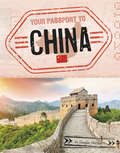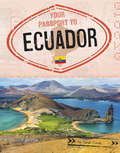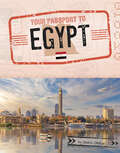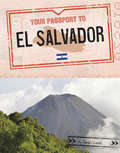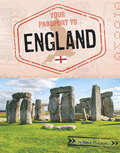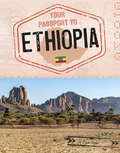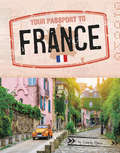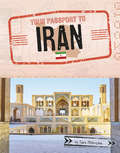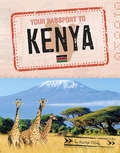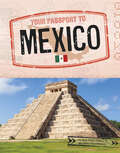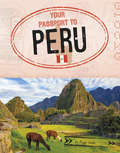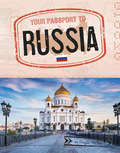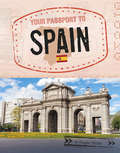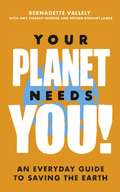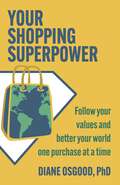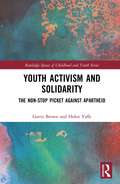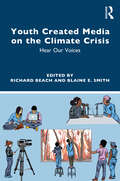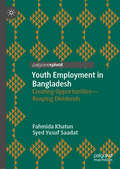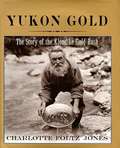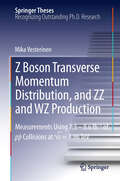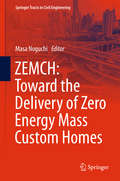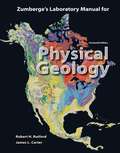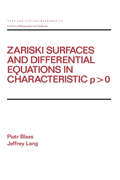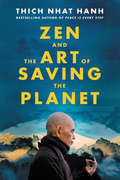- Table View
- List View
Your Passport to China (World Passport)
by Douglas HustadWhat would it be like to live in China? How is China's culture unique? Explore the sights, traditions, and daily lives of the Chinese!
Your Passport to Ecuador (World Passport)
by Sarah CordsWhat would it be like to live in Ecuador? How is Ecuador's culture unique? Explore the sights, traditions, and daily lives of Ecuadorians!
Your Passport to Egypt (World Passport)
by Golriz GolkarWhat is it like to live in or visit Egypt? What makes Egypt’s culture unique? Explore the geography, traditions, and daily lives of Egyptian people.
Your Passport to El Salvador (World Passport)
by Sarah CordsWhat would it be like to live in El Salvador? How is El Salvador's culture unique? Explore the sights, traditions, and daily lives of El Salvadorians!
Your Passport to England (World Passport)
by Nancy DickmannWhat is it like to live in or visit England? What makes England’s culture unique? Explore the geography, traditions, and daily lives of England's people.
Your Passport to Ethiopia (World Passport)
by Ryan GaleWhat would it be like to live in Ethiopia? How is Ethiopia's culture unique? Explore the sights, traditions, and daily lives of Ethiopians!
Your Passport to France (World Passport)
by Charly HaleyWhat would it be like to live in France? How is France's culture unique? Explore the sights, traditions, and daily lives of the French!
Your Passport to Iran (World Passport)
by Sara PetersohnWhat would it be like to live in Iran? How is Iran's culture unique? Explore the sights, traditions, and daily lives of Iranians!
Your Passport to Kenya (World Passport)
by Kaitlyn DulingWhat would it be like to live in Kenya? How is Kenya's culture unique? Explore the sights, traditions, and daily lives of Kenyans!
Your Passport to Mexico (World Passport)
by Isela Xitlali Gómez Anaïs Deal-MárquezWhat is it like to live in or visit Mexico? What makes Mexico's culture unique? Explore the geography, traditions, and daily lives of Mexican people.
Your Passport to Peru (World Passport)
by Ryan GaleWhat would it be like to live in Peru? How is Peru's culture unique? Explore the sights, traditions, and daily lives of Peruvians!
Your Passport to Russia (World Passport)
by Douglas HustadWhat would it be like to live in Russia? How is Russia's culture unique? Explore the sights, traditions, and daily lives of Russians!
Your Passport to Spain (World Passport)
by Douglas HustadWhat would it be like to live in Spain? How is Spain's culture unique? Explore the sights, traditions, and daily lives of Spaniards!
Your Planet Needs You!: An everyday guide to saving the earth
by Bernadette Vallely Amy Charuy-Hughes Bethan Stewart JamesIf there was ever a time to stand up for your planet, for Mother Earth, this is the time. But what are the most pressing environmental issues affecting us today? And what actions can you, as an individual, take to combat them? If you want to know what you can do, then this is the book for you. Your Planet Needs You is the essential beginner's guide to understanding the environment and the threats to its wellbeing. From plastic waste to pesticides, food production and chemicals, global warming to species extinction, this book covers the topics that you need to know about.With practical and positive tips, this book will show how you can be part of the solution and help make a better world, whatever age you are.Includes sections on air pollution, environmental law, fast fashion and ethical living, as well as resources such as recommended reading and lists of groups and organisations that you can get involved with.
Your Shopping Superpower: Follow Your Values and Better Your World One Purchase at a Time
by Diane OsgoodYour Shopping Superpower provides an insightful guide and strategies for shoppers to align the contents in their carts with their personal values.Are there harmful toxins in your food and body care? Who makes the products you purchase and under what conditions? What impact does the production of these items have on the environment? If 70% of the U.S. economy is driven by consumer spending, then every purchase we make has a physical and social impact on the world. Unfortunately, our shopping choices can unintentionally contribute to climate change and social injustice. Many people wish they could do more to combat these unjust and unsustainable outcomes. So what is the connection between our purchases and this impact? Your Shopping Superpower explores this important question and offers a comprehensive guide that navigates toward positive and sustainable shopping practices by providing pragmatic tips, tools and revealing how our habits can help reduce climate change, support companies with equitable workplace conditions, and foster diverse, local businesses. Broken into categories including People, Planet, Community, and Health, Diane Osgood expands on key issues regarding climate degradation, labor exploitation, products containing carcinogens and toxins, and the importance of supporting local, women-owned, and minority-owned businesses while covering an array of products that include food, fashion, gifts, household items, and personal care. Addressing shoppers&’ doubts about whether consumer choices truly have an impact and their concerns about costs and accessibility, Osgood shows how making these easy changes fosters happiness. With helpful diagrams and firsthand stories on climate and social injustice, Your Shopping Superpower informs and guides shoppers on how to: Implement one change per week Identify trustworthy certifications, rating systems, and apps Detect greenwashing and other misleading marketing Determine which purchases to switch for maximum impact Handle and approach choices that aren&’t easy or affordable By changing what we buy, we can initiate the change in our economy's environmental footprint and social impact. To enact change, we must start simple; it&’s about progress, not perfection.
Youth Activism and Solidarity: The non-stop picket against Apartheid (Routledge Spaces of Childhood and Youth Series)
by Gavin Brown Helen YaffeFrom April 1986 until just after Nelson Mandela’s release from prison in February 1990, supporters of the City of London Anti-Apartheid Group maintained a continuous protest, day and night, outside the South African Embassy in central London. This book examines how and why a group of children, teenagers and young adults made themselves ‘non-stop against apartheid’, creating one of the most visible expressions of anti-apartheid solidarity in Britain. Drawing on interviews with over ninety former participants in the Non-Stop Picket of the South African Embassy and extensive archival research using previously unstudied documents, this book offers new insights to the study of social movements and young people’s lives. It theorises solidarity and the processes of adolescent development as social practices to provide a theoretically-informed, argument-led analysis of how young activists build and practice solidarity. Youth Activism and Solidarity: The Non-Stop Picket Against Apartheid will be of interest to geographers, historians and a wide range of other social scientists concerned with the historical geography of the international anti-apartheid movement, social movement studies, contemporary British history, and young people’s activism and geopolitical agency.
Youth Created Media on the Climate Crisis: Hear Our Voices
by Richard Beach Blaine E. SmithThis timely book provides effective methods and authentic examples of teaching about climate change through digital and multimodal media production in the English Language Arts classroom. The chapters in this edited volume demonstrate the benefits of addressing climate change in the classroom through innovative media production and cover a range of different types of media, including video/digital storytelling, social media, art, music, and writing, with rich resources for instruction in every chapter. Through the engaging ideas and strategies, the contributors equip educators with the critical tools for supporting students’ media production. In so doing, they offer new perspectives on how students can employ media and production techniques to critique the status quo, call for change, and acquire new literacy skills. As the effects of the climate crisis become increasingly visible to the youth population, this book helps foster and support youth agency and activism. Youth Media Creation on the Climate Change Crisis: Hear Our Voices is a necessary text for students, preservice teachers, and educators in literacy education, media studies, social and environmental studies, and STEM education. The eBook+ version of the text features embedded audio and video components as well as interactive links to reflect the multimodal nature of students’ work, spotlighting how youth media production supports the development of students’ critical literacy skills and shapes their voices and identities.
Youth Employment in Bangladesh: Creating Opportunities—Reaping Dividends
by Fahmida Khatun Syed Yusuf SaadatThis book brings together pioneering and evidence-based research that focuses on youth employment—one of the foremost development challenges of our time—and fills a critical research and knowledge gap alongside consolidating existing relevant literature. Comprehensive in scope, the book provides an overview of trends in youth employment in Bangladesh, empirically analyses the determinants of youth unemployment, covers relevant economic theory, and recommends policy measures for employment creation in Bangladesh. The new evidence from Bangladesh on the aforesaid issues will inform relevant and concurrent policy discourse, add value to related research in the field, and inspire future research. The insights gathered through this study will serve as an important lesson for other developing countries on what works and what does not in policy-making.
Yukon Gold: The Story of the Klondike Gold Rush
by Charlotte Foltz JonesRecounts the quest for gold that took place in the late 1890s in the Klondike region of the Yukon Territory of northwestern Canada
Z Boson Transverse Momentum Distribution, and ZZ and WZ Production
by Mika VesterinenThis work develops novel data analysis techniques enabling aspects of the Standard Model of particle physics to be tested with unprecedented precision using data from the DZero experiment at the high energy "Tevatron" proton-antiproton collider at Fermilab, Chicago. Vesterinen's measurements of the transverse momentum of Z bosons using the novel variable φ* have exposed deficiencies in the current state-of-the-art theoretical predictions for vector boson production at hadron colliders. These techniques are now being used in the experiments at CERN's Large Hadron Collider (LHC) and have stimulated considerable interest in the theoretical particle physics community. Furthermore, Vesterinen's measurements of the cross sections for the production of pairs of vector bosons (WZ and ZZ) are to date the most precise ever made.
ZEDlife
by Bill DunsterThe argument for low-cost, zero-energy, zero-waste architecture has never been timelier, while the mainstream has largely abandoned or neglected this agenda: in the UK the recent mandatory zero-carbon performance targets for new homes have been postponed or forgotten at a time when thousands of new homes will be built, and there is already a shortage of electric generating capacity. This book offers a forceful challenge to the current addiction to overconsumption of natural capital and energy, and provides workable, sustainable solutions for zero-carbon, zero-waste design.
ZEMCH: Toward the Delivery of Zero Energy Mass Custom Homes
by Masa NoguchiIn this book, leading international experts explore the emerging concept of the zero energy mass custom home (ZEMCH) - designed to meet the need for social, economic, and environmental sustainability - and provide all of the knowledge required for the delivery of zero energy mass customized housing and community developments in developed and developing countries. The coverage is wide ranging, progressing from explanation of the meaning of sustainable development to discussion of challenges and trends in mass housing, the advantages and disadvantages of prefabricated methods of construction, and the concepts of mass customization, mass personalization, and inclusive design. A chapter on energy use will aid the reader in designing and retrofitting housing to reduce energy demand and/or improve energy end‐use efficiency. Passive design strategies and active technologies (especially solar) are thoroughly reviewed. Application of the ZEMCH construction criteria to new buildings and refurbishment of old houses is explained and the methods and value of building performance simulation, analyzed. The concluding chapter presents examples of ZEMCH projects from around the world, with discussion of marketing strategy, design, quality assurance, and delivery challenges. The book will be invaluable as a training/teaching tool for both students and industry partners.
ZUMBERGE'S LABORATORY MANUAL FOR Physical Geology
by James Zumberge Robert H. Rutford James L. CarterLaboratory Manual for Physical Geology, 14e is written for the freshman-level laboratory course in physical geology. In this lab, students study Earth materials, geologic interpretation of topographic maps, aerial photographs and Earth satellite imagery, structural geology and plate tectonics and related phenomena. With over 30 exercises, professors have great flexibility when developing the syllabus for their physical geology lab course.
Zariski Surfaces and Differential Equations in Characteristic P < O (Chapman And Hall/crc Pure And Applied Mathematics Ser. #106)
by Piotr BlassThis book represents the current (1985) state of knowledge about Zariski surfaces and related topics in differential equations in characteristic p > 0. It is aimed at research mathematicians and graduate and advanced undergraduate students of mathematics and computer science.
Zen and the Art of Saving the Planet
by Thich Nhat Hanh“When you wake up and you see that the Earth is not just the environment, the Earth is us, you touch the nature of interbeing. And at that moment you can have real communication with the Earth… We have to wake up together. And if we wake up together, then we have a chance. Our way of living our life and planning our future has led us into this situation. And now we need to look deeply to find a way out, not only as individuals, but as a collective, a species.”-- Thich Nhat HanhWe face a potent intersection of crises: ecological destruction, rising inequality, racial injustice, and the lasting impacts of a devastating pandemic. The situation is beyond urgent. To face these challenges, we need to find ways to strengthen our clarity, compassion, and courage to act.Beloved Zen Master Thich Nhat Hanh is blazingly clear: there’s one thing we all have the power to change, which can make all the difference, and that is our mind. Our way of looking, seeing, and thinking determines every choice we make, the everyday actions we take or avoid, how we relate to those we love or oppose, and how we react in a crisis.Mindfulness and the radical insights of Zen meditation can give us the strength and clarity we need to help create a regenerative world in which all life is respected. Filled with Thich Nhat Hanh’s inspiring meditations, Zen stories and experiences from his own activism, as well as commentary from Sister True Dedication, one of his students Zen and the Art of Saving the Planet shows us a new way of seeing and living that can bring healing and harmony to ourselves, our relationships, and the Earth.
